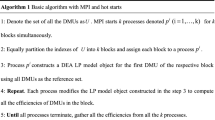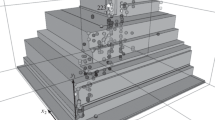Abstract
Build Hull is currently one of the most efficient methods to address the large-scale data envelopment analysis problem. In this paper, the computational complexity of Build Hull is established, implying that the dimension of the data set has a strong influence on computational efficiency. Based on the complexity result, we find that the “worst density” of Build Hull monotonically increases with respect to dimension. In addition, a two-phase parallel Build Hull algorithm is proposed to enhance the computational efficiency of Build Hull. The parallel procedure is based on the minimum volume enclosing ellipsoid technique, which enables the exclusion of a large number of DMUs in the first phase. A sensitivity analysis-based technique is also proposed to substantially reduce computational time in the second phase. Numerical tests support our theoretical results.






Similar content being viewed by others
Notes
Applying the simplex method to solve a standard linear program model:
$$\begin{aligned} \begin{array}{cl}\min \limits _x &{} c^T x\\ \text {s.t.} &{} Ax=b,\\ \ &{} x\ge 0\\ \end{array} \end{aligned}$$with \(A\in \mathbb {R}^{m\times n}\), rank\((A)=m<n\), it needs at most \(n \atopwithdelims ()m\) iterations, and O(mn) flops are needed during each iteration.
Let the MVEE of data set \(\mathcal {A}\) be E(H, c). Then, the homothetic ellipsoid \(\frac{1}{m} E(H,c)\) is contained in the convex hull of \(\mathcal {A}\).
References
Ali, A. I. (1993). Streamlined computation for data envelopment analysis. European Journal of Operational Research, 64(1), 61–67.
Barr, R. S., & Durchholz, M. L. (1997). Parallel and hierarchical decomposition approaches for solving large-scale data envelopment analysis models. Annals of Operations Research, 73, 339–372.
Bertsimas, D., & Tsitsiklis, J. N. (1997). Introduction to linear optimization (Vol. 6). Belmont: Athena Scientific.
Bougnol, M. L., & Dulá, J. H. (2009). Anchor points in dea. European Journal of Operational Research, 192(2), 668–676.
Charnes, A., & Neralić, L. (1990). Sensitivity analysis of the additive model in data envelopment analysis. European Journal of Operational Research, 48(3), 332–341.
Charnes, A., Cooper, W. W., Lewin, A. Y., Morey, R. C., & Rousseau, J. (1984). Sensitivity and stability analysis in dea. Annals of Operations Research, 2(1), 139–156.
Charnes, A., Cooper, W. W., Golany, B., Seiford, L., & Stutz, J. (1985). Foundations of data envelopment analysis for pareto-koopmans efficient empirical production functions. Journal of Econometrics, 30(1–2), 91–107.
Chen, W. C., & Cho, W. J. (2009). A procedure for large-scale dea computations. Computers & Operations Research, 36(6), 1813–1824.
Chen, W. C., & Lai, S. Y. (2017). Determining radial efficiency with a large data set by solving small-size linear programs. Annals of Operations Research, 250(1), 147–166.
Chu, J. F., Wu, J., & Song, M. L. (2018). An sbm - dea model with parallel computing design for environmental efficiency evaluation in the big data context: A transportation system application. Annals of Operations Research, 270(1–2), 105–124.
Cooper, W. W., Seiford, L. M., & Tone, K. (2006). Introduction to data envelopment analysis and its uses: with DEA-solver software and references. Berlin: Springer.
Dantzig, G. (2016). Linear programming and extensions. Princeton: Princeton University Press.
Dulá, J., & López, F. (2013). Dea with streaming data. Omega, 41(1), 41–47.
Dulá, J., & Thrall, R. (2001). A computational framework for accelerating dea. Journal of Productivity Analysis, 16(1), 63–78.
Dulá, J. H. (2008). A computational study of dea with massive data sets. Computers & Operations Research, 35(4), 1191–1203.
Dulá, J. H. (2011). An algorithm for data envelopment analysis. INFORMS Journal on Computing, 23(2), 284–296.
Dulá, J. H., & Helgason, R. V. (1996). A new procedure for identifying the frame of the convex hull of a finite collection of points in multidimensional space. European Journal of Operational Research, 92(2), 352–367.
Dulá, J. H., & López, F. J. (2009). Preprocessing dea. Computers & Operations Research, 36(4), 1204–1220.
Dulá, J. H., Helgason, R. V., & Venugopal, N. (1998). An algorithm for identifying the frame of a pointed finite conical hull. INFORMS Journal on Computing, 10(3), 323–330.
Emrouznejad, A., Parker, B. R., & Tavares, G. (2008). Evaluation of research in efficiency and productivity: A survey and analysis of the first 30 years of scholarly literature in dea. Socio-Economic Planning Sciences, 42(3), 151–157.
Khezrimotlagh, D., Zhu, J., Cook, W. D., & Toloo, M. (2019). Data envelopment analysis and big data. European Journal of Operational Research, 274(3), 1047–1054.
Mahmoudi, R., Emrouznejad, A., Shetab-Boushehri, S. N., & Hejazi, S. R. (2018). The origins, development and future directions of data envelopment analysis approach in transportation systems. Socio-Economic Planning Sciences,.
Mishra, D., Gunasekaran, A., Papadopoulos, T., & Childe, S. J. (2018). Big data and supply chain management: a review and bibliometric analysis. Annals of Operations Research, 270(1–2), 313–336.
Song, M. L., Fisher, R., Wang, J. L., & Cui, L. B. (2018). Environmental performance evaluation with big data: Theories and methods. Annals of Operations Research, 270(1–2), 459–472.
Sueyoshi, T., & Chang, Y. L. (1989). Efficient algorithm for additive and multiplicative models in data envelopment analysis. Operations Research Letters, 8(4), 205–213.
Tao, J., Zhang, W., & Lu, C. (2017). Global linear convergent algorithm to compute the minimum volume enclosing ellipsoid. arXiv:1702.06254
Thompson, R. G., Dharmapala, P., Diaz, J., González-Lima, M. D., & Thrall, R. M. (1996). Dea multiplier analytic center sensitivity with an illustrative application to independent oil companies. Annals of Operations Research, 66(2), 163–177.
Todd, M. J. (2016). Minimum-volume ellipsoids: Theory and algorithms (Vol. 23). Philadelphia: SIAM.
Wheelock, D. C., & Wilson, P. W. (2000). Why do banks disappear? the determinants of us bank failures and acquisitions. Review of Economics and Statistics, 82(1), 127–138.
Zhu, Q., Wu, J., & Song, M. (2018). Efficiency evaluation based on data envelopment analysis in the big data context. Computers & Operations Research, 98, 291–300.
Acknowledgements
This research is supported by National Natural Science Foundation of China Grant No. 7160010139 and 71704101, Soft Science Foundation of Shanghai Grant No. 19692104600, and Humanities and Social Science Fund of Ministry of Education of China Grant No. 17YJC630094.
Author information
Authors and Affiliations
Corresponding author
Additional information
In memory of my Mum, Wen Zonglan.
Publisher's Note
Springer Nature remains neutral with regard to jurisdictional claims in published maps and institutional affiliations.
Rights and permissions
About this article
Cite this article
Jie, T. Parallel processing of the Build Hull algorithm to address the large-scale DEA problem. Ann Oper Res 295, 453–481 (2020). https://doi.org/10.1007/s10479-020-03698-2
Published:
Issue Date:
DOI: https://doi.org/10.1007/s10479-020-03698-2




